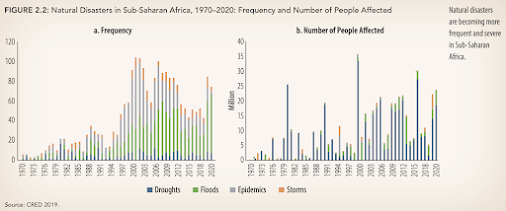Climate Change Impacts to Africa and The Extreme Weathers
Hi and welcome back to my blog!
Since I have talked about the general situation of Africa’s water under the influence of climate change in my last blogs, I would like to share you more with the elaboration of a few case studies of extreme events around Africa starting from this blog, which then shows the physical and humanitarian impacts to the affected area from different extent.
A series of problems associated with water in Africa has been triggered by climate change. Rising temperature and variations in rainfall across Africa lead to an increase in the frequency and intensity of extreme weather events — heatwaves, droughts, floods, and storms, among others, which continues to hit Africa’s water condition and affect human well being to a great extent over past four decades.
The rate of temperature rise for Africa in recent decades has been recorded at a rapid trend (faster than global mean temperature) that can be comparable to most other continents, with the latest prediction showing continued warming and decreasing rainfall especially over North and Southern regions, and increased rainfall over the Sahel from 2020 to 2024 (IPCC). The temperature is expected to rise by five degrees or more, especially in the regions of Namibia, Botswana and Zambia, which resulted in the year 2020 being the fourth warmest year in Africa since 1910. This has contributed to the occurrence of large extreme events, such as the cyclone Idai and the positive Indian Ocean Dipole events over the West Indian Ocean in recent years.
Figure 1 Trends in mean surface temperature of Africa, 1920-2020 (degrees Celsius)
The extreme events, such as flash floods and droughts, have caused great destruction over the continent, with the frequency of droughts nearly tripled by 2010-19 compared with 1970-79, it has more than quadrupled for storms, and it has increased more than tenfold in the case of floods (see figure 1). Floods then have occupied the highest share in the total natural disasters. Sub-Sahara Africa shares 20 per cent of global floods, which contributes to the rapid growth of total natural disasters in the last decade. The impacts from these events vary between different geographic locations and months of the year, which affect the local community at different scales.
Figure 2 Frequency and Number of People Affected by Natural Disasters in Sub-Saharan Africa from 1970 to 2020.
Figure 3 The distribution of natural disasters across Sub-Saharan African Countries from 2000 to 2019.
As shown in figure 3, the continent experience very different types of natural disasters when it comes to the various geographic locations, due to their size and complexity. The IPCC reports that climate change in Africa is manifested by more severe and longer-lasting droughts in subtropical and tropical regions, while arid or semi-arid areas in parts of northern, western, eastern and southern Africa have become drier and more vulnerable to the changes of precipitation and storms. As a result, farmers in Southeastern Africa have suffered from years of drought and occasional heavy rainfalls which result in flooding. This fact indicates that there are many uncertainties behind our projection to the future climate change, which is the main focus of scientists’ research and should be worth for everyone to care about.
From 2000 to 2019, most people on the continent were affected by drought, such as those in Sudan, Ethiopia and Kenya, followed by flash floods resulting from the unstable and intensive rainfall in recent years. Although Kenya and South Africa were most affected by droughts, according to the world bank, these two areas combined with Mozambique experienced 75 per cent of the region’s floods and storms, which generated great challenges to the local people via the destruction of human lives and local economy. Since 2020, more than 58,800 people were affected, at least 28 of them died in Mozambique, and more than 10,200 houses and 45 schools were destroyed by rain and flooding in Mozambique, which was brought by the tropical Cyclone Idai in March 2019.






Comments
Post a Comment